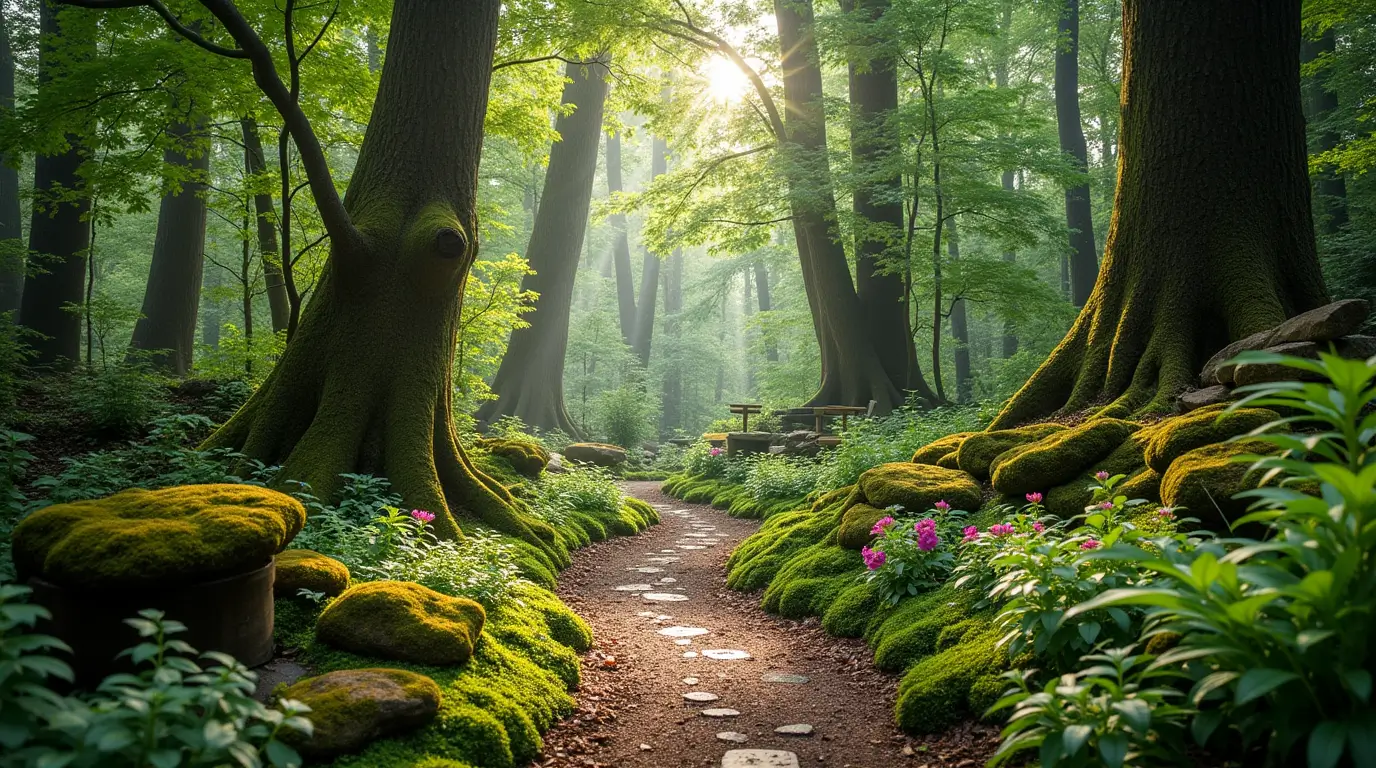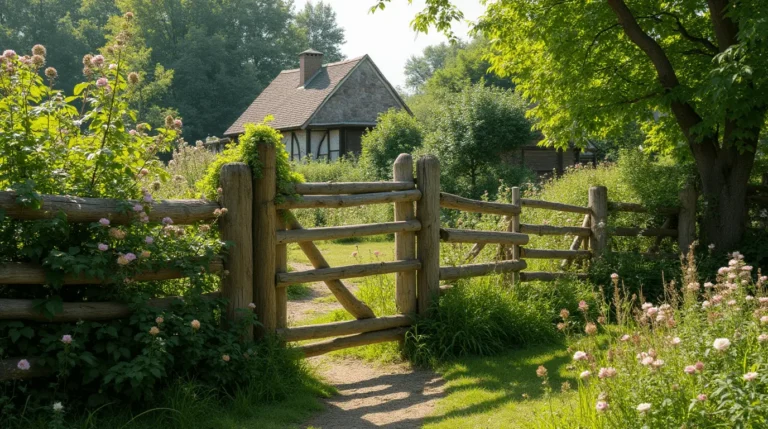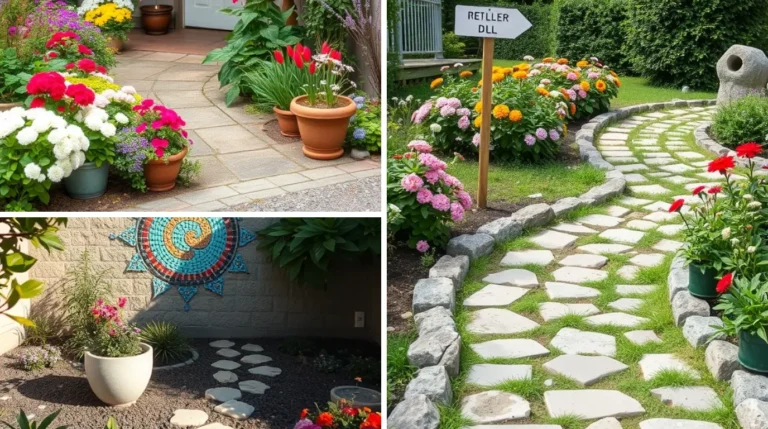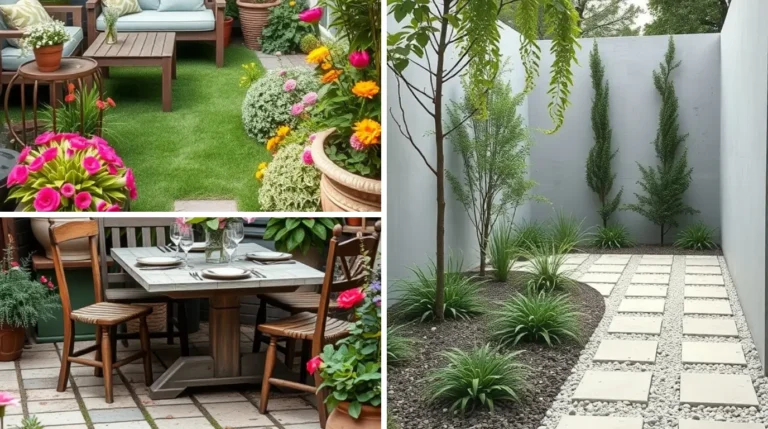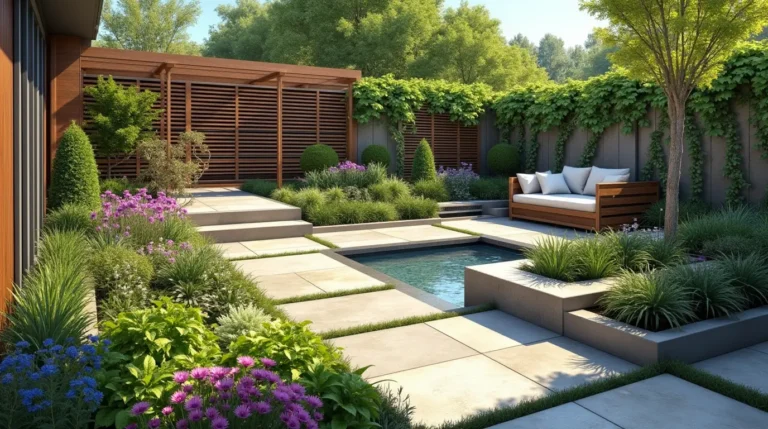Garden in the Woods: Ideas for a Perfect Woodland Retreat
Creating a garden in the woods is an enchanting way to merge the beauty of nature with the tranquility of a personal retreat. Woodland gardening emphasizes harmony with the environment, utilizing shade-tolerant plants, natural features, and sustainable practices to craft a serene outdoor space.
The benefits of a woodland garden go beyond aesthetics. These spaces offer:
- Serenity: A peaceful escape from daily stresses, surrounded by the soothing sounds of nature.
- Natural Beauty: A lush, organic landscape filled with vibrant greenery and seasonal blooms.
- Wildlife Habitat: An inviting home for birds, butterflies, and other creatures, promoting biodiversity.
In this blog, you’ll discover practical tips for designing your woodland garden, selecting the right plants, and incorporating natural features to create a perfect woodland retreat. Whether you’re starting from scratch or enhancing an existing space, this guide will inspire you to bring the magic of the forest to your backyard.
Understanding the Essence of a Woodland Garden
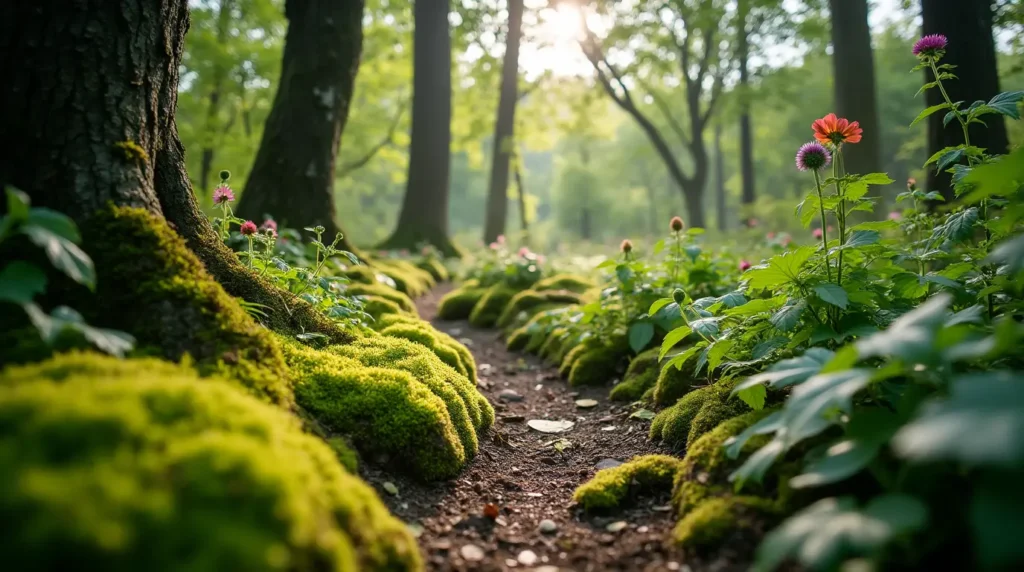
A woodland garden is a space that embodies the beauty and tranquility of a natural forest while incorporating thoughtful design elements to create a cohesive outdoor retreat. Unlike formal gardens, which focus on symmetry and structure, woodland gardens thrive on their organic, free-flowing aesthetic, allowing nature to guide the design process.
What Defines a Woodland Garden?
At its core, a woodland garden is characterized by:
- Shade-dominated spaces: These gardens are usually established under the canopy of mature trees, creating a cool and shaded environment.
- Naturalistic planting schemes: Plants are chosen and arranged to mimic the patterns found in wild forests, blending seamlessly with their surroundings.
- Diverse flora and fauna: A mix of native and shade-tolerant plants provides food and shelter for local wildlife, creating a thriving ecosystem.
- Rustic features: Elements like moss-covered rocks, wooden benches, and natural pathways enhance the forest-like feel of the space.
Why Choose a Garden in the Woods?
Woodland gardens are perfect for those who want to embrace the beauty of nature without the high maintenance associated with traditional gardens. Key reasons to create a woodland garden include:
- Low-maintenance appeal: Once established, these gardens require minimal upkeep, as they rely on natural processes like leaf litter mulching and rainwater irrigation.
- Eco-friendliness: Woodland gardens prioritize sustainability by using native plants, reducing water consumption, and avoiding artificial fertilizers or pesticides.
- Tranquil atmosphere: The dappled sunlight, gentle rustle of leaves, and presence of wildlife make woodland gardens ideal for relaxation and reflection.
Inspiration from Nature
Designing a woodland garden often begins with observing natural forests. Take note of how plants layer themselves, from towering trees to ground-covering mosses. Pay attention to the interplay of light and shade, the textures of bark and foliage, and the seasonal changes in a woodland setting.
You can take inspiration from examples like:
- Wildflower meadows within wooded areas: Incorporating native wildflowers to add color and support pollinators.
- Shaded trails with lush greenery: Creating pathways that invite exploration while maintaining a natural look.
- Hidden retreats within the forest: Adding cozy seating areas or small clearings for personal reflection or family gatherings.
By understanding the essence of a woodland garden, you can create a space that not only enhances your outdoor living area but also celebrates the wonder and serenity of the natural world.
Planning Your Woodland Retreat: Design Tips
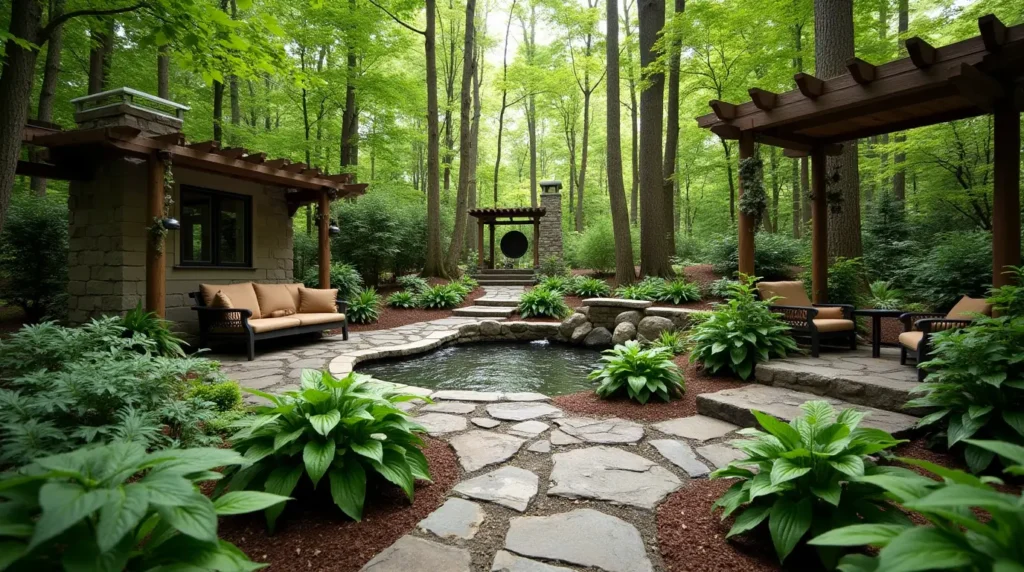
Designing a woodland retreat requires thoughtful planning to ensure your garden captures the essence of a natural forest while meeting your personal needs. By assessing your space, planning the layout, and incorporating key features, you can create a harmonious, inviting woodland garden that balances functionality and beauty.
Assessing Your Space
Before diving into design, it’s essential to evaluate your garden area to understand its unique characteristics:
- Sunlight levels: Observe how light filters through the trees during different times of the day. Woodland gardens thrive in partial to full shade, so identifying these zones is crucial for plant selection.
- Evaluate your soil by testing its pH and nutrient content. Woodland soil is typically rich in organic matter, but you may need to amend the soil to match the needs of your chosen plants.
- Existing vegetation: Take note of the trees, shrubs, and ground cover already present. Incorporate these into your design to preserve the natural beauty of the space and minimize disruption to the ecosystem.
Natural Pathways and Layouts
Pathways are vital for navigating and enjoying your woodland garden. They should blend seamlessly with the environment and invite exploration. Consider the following options:
- Gravel paths: Affordable and easy to maintain, gravel paths provide a rustic look while allowing for drainage.
- Stepping stones: Use flat stones to create a meandering trail that mimics natural footpaths.
- Mulched trails: Organic mulch, such as bark or wood chips, offers a soft, natural surface that decomposes over time, enriching the soil.
- Meandering layouts: Avoid straight lines; instead, design curving paths that lead to hidden nooks or focal points for a sense of discovery.
Creating Focal Points
Focal points draw attention and add personality to your garden. In a woodland retreat, these elements should feel natural and understated. Ideas include:
- Rustic seating areas: Place a wooden bench or stone seat in a shaded corner for a quiet spot to relax.
- Small water features: Add a birdbath, fountain, or small pond to bring the soothing sound of water and attract wildlife.
- Decorative elements: Use items like driftwood, moss-covered stones, or sculptures made from natural materials to enhance the woodland atmosphere.
Layering Your Landscape
The beauty of a woodland garden lies in its layered structure, which mimics the natural growth patterns of a forest. Enhance depth and visual intrigue by integrating:
- Canopy layer: Mature trees like oaks, maples, or birches provide shade and structure.
- Understory layer: Small trees and shrubs, such as dogwoods or azaleas, add color and texture.
- Ground cover: Plants like ferns, hostas, and mosses fill in gaps, creating a lush forest floor.
By carefully planning your woodland retreat, you’ll be able to design a garden that’s not only beautiful but also practical and sustainable. Each element should feel like an extension of the natural environment, blending seamlessly into the woodland setting.
Choosing the Right Plants for a Woodland Garden
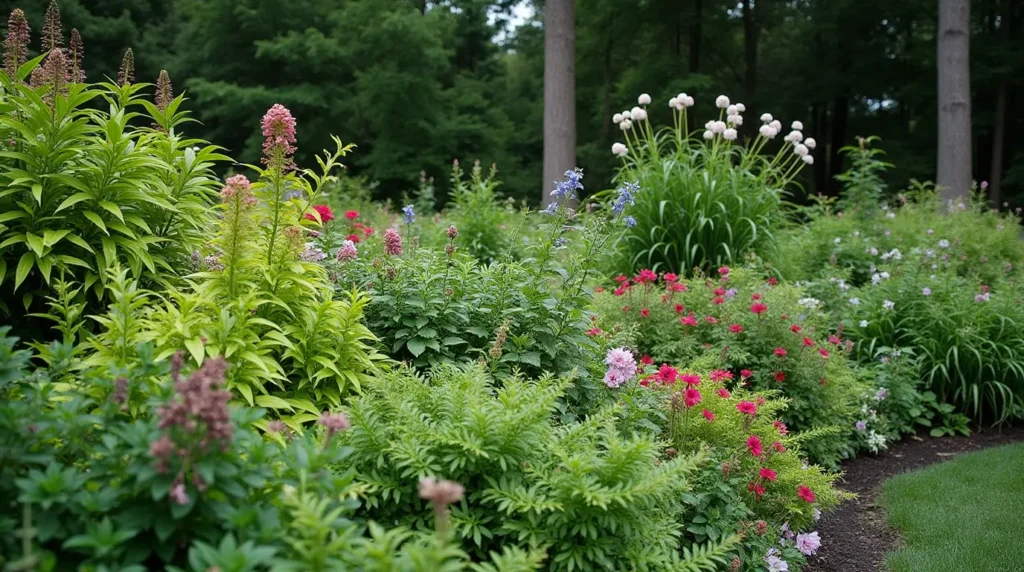
The success of a woodland garden largely depends on selecting plants that thrive in shaded and semi-shaded conditions while complementing the natural aesthetic of a forest. The right mix of plants will provide year-round interest, support local wildlife, and create a lush, layered look that mimics a natural woodland.
Shade-Tolerant Plants
Shade is a defining feature of woodland gardens, making shade-tolerant plants the backbone of your design. Here are some excellent options for different layers of your garden:
- Ferns: Their delicate, feathery fronds add texture and elegance to the garden floor.
- Hostas: Known for their large, vibrant leaves in various shades of green, blue, and yellow.
- Astilbe: Produces feathery plumes of flowers in shades of pink, red, or white that brighten shaded areas.
- Bleeding Heart (Dicentra): A favorite for its heart-shaped flowers and delicate foliage.
Native Woodland Plants
Using native plants is a sustainable choice that benefits the environment and reduces maintenance. These plants are adapted to local soil, light, and weather conditions, making them more resilient and easier to care for.
- Wildflowers: Include native species like trilliums, jack-in-the-pulpit, and bluebells for pops of color.
- Native groundcovers: Plants like wild ginger, wood sorrel, or creeping phlox thrive under the canopy while preventing soil erosion.
- Shrubs and small trees: Incorporate dogwoods, serviceberries, or witch hazel for structure and seasonal interest.
Seasonal Interest
A well-planned woodland garden should offer beauty in every season. Choose plants that provide color, texture, and movement throughout the year:
- Spring: Add bulbs like snowdrops, daffodils, and hellebores to bring early blooms to shaded areas.
- Summer: Focus on lush foliage with hostas, ferns, and flowering shrubs like hydrangeas.
- Autumn: Select plants with vibrant fall foliage, such as Japanese maples or sumac. Incorporate grasses like Hakonechloa for golden tones.
- Winter: Evergreen shrubs like holly, yew, or boxwood maintain structure, while red-twig dogwood adds vibrant color.
Layering for a Forest Effect
Woodland gardens are visually appealing because of their layered structure, replicating the natural composition of a forest. Use the following approach:
- Canopy layer: Large trees like oak, maple, or pine provide shade and define the garden’s structure.
- Understory layer: Small trees or tall shrubs like redbud, dogwood, or viburnum fill the mid-level.
- Ground layer: Low-growing plants, including groundcovers, ferns, and mosses, create a lush forest floor.
Planting for Pollinators and Wildlife
A woodland garden can be a haven for birds, bees, butterflies, and other wildlife.
- Pollinator-friendly flowers: Include species like native milkweed, foxgloves, and columbine to attract bees and butterflies.
- Fruiting plants: Shrubs like elderberry, blueberry, or hawthorn provide food for birds.
- Habitat plants: Dense shrubs and tall grasses offer shelter for small animals and nesting birds.
By carefully choosing plants that suit your woodland garden’s conditions and aesthetic, you’ll create a thriving, sustainable space that celebrates the beauty of nature while requiring minimal maintenance.
Enhancing Your Woodland Garden with Natural Features
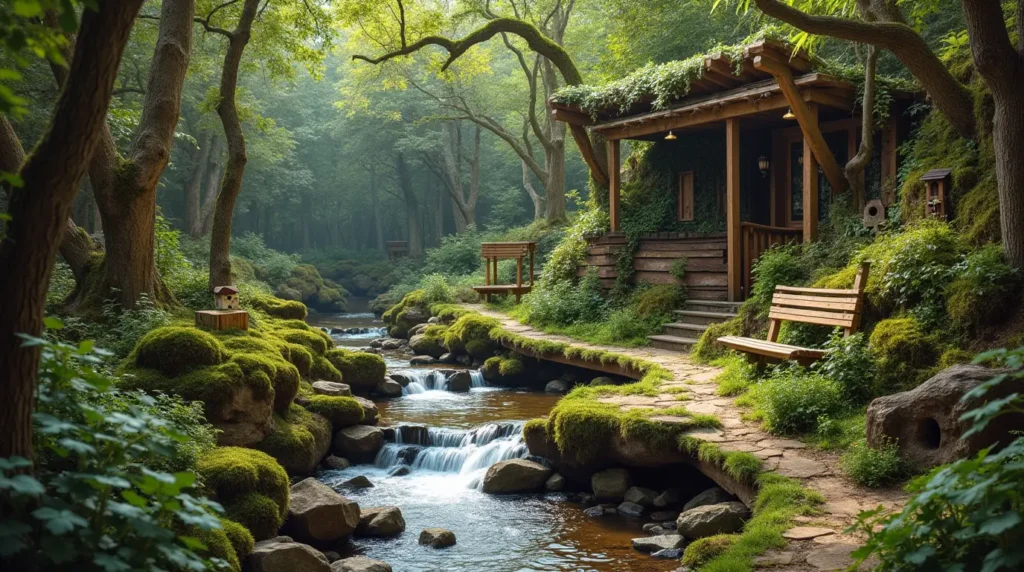
Adding natural features to your woodland garden can elevate its charm and authenticity, transforming it into a serene retreat that feels like an untouched forest. These elements not only enhance the visual appeal but also create a sensory experience, with sounds, textures, and scents that immerse visitors in the beauty of nature.
Water Features
Water is a powerful addition to a woodland garden, offering both aesthetic and practical benefits. The soothing sound of flowing water creates a tranquil atmosphere while attracting birds, frogs, and other wildlife. Consider these options:
- Ponds: A small, natural-looking pond can serve as the focal point of your garden. Surround it with shade-loving plants like ferns and irises for a seamless blend with the environment.
- Streams and creeks: If your garden has a natural slope, create a gentle stream or cascading creek using rocks and pebbles.
- Fountains: Opt for rustic designs like stone basins or carved wood to maintain the woodland theme.
Rock and Stone Accents
Rocks and stones are quintessential woodland elements, adding texture, structure, and a sense of permanence to your garden.
- Boulder clusters: Use large stones to create natural seating areas or accentuate pathways.
- Stepping stones: Integrate flat stones into your garden paths for a functional and aesthetic addition.
- Rock gardens: Combine stones with low-maintenance plants like mosses and succulents to craft a rugged yet beautiful feature.
Wooden Structures and Features
Wood is an ideal material for woodland gardens, blending effortlessly with the natural surroundings while adding functionality.
- Benches and seating: Install simple wooden benches or log seats in shaded areas for a rustic and inviting look.
- Pergolas and arbors: Use wooden frameworks to support climbing plants like wisteria or clematis, creating enchanting entryways or shaded alcoves.
- Tree stumps: Repurpose tree stumps as plant stands, stools, or decorative features.
Moss and Ground Covers
Moss and other ground covers can add a touch of magic to your woodland garden. These low-maintenance plants thrive in shady, moist environments and create a soft, carpet-like texture.
- Moss beds: Use moss to cover rocks, tree stumps, or bare patches of soil for a lush, green look.
- Creeping plants: Incorporate plants like creeping thyme or vinca minor to fill gaps and suppress weeds.
Wildlife-Friendly Features
Encouraging wildlife to visit your garden adds life and movement, making the space feel like a thriving ecosystem.
- Birdhouses and feeders: Install wooden birdhouses and feeders to attract local birds. Place them at varying heights for diversity.
- Bug hotels: Create small shelters using hollow stems, logs, and bark to provide habitat for beneficial insects like bees and ladybugs.
- Log piles: Stack logs or branches in a corner of your garden to create a habitat for small mammals, insects, and fungi.
Seasonal Decor and Natural Accents
Add seasonal interest with temporary or permanent natural decorations:
- Fall leaves: Leave some fallen leaves to naturally mulch the soil and create a vibrant autumnal display.
- Winter branches: Use evergreen boughs or red-twig dogwood to add winter color.
- Wildflower patches: Allow native wildflowers to grow freely in open spaces for bursts of seasonal color.
By incorporating these natural features into your woodland garden, you can craft a space that feels alive and harmonious with the surrounding environment. Each feature adds a layer of interest and functionality, enhancing the overall experience of your woodland retreat.
Maintaining Your Woodland Retreat
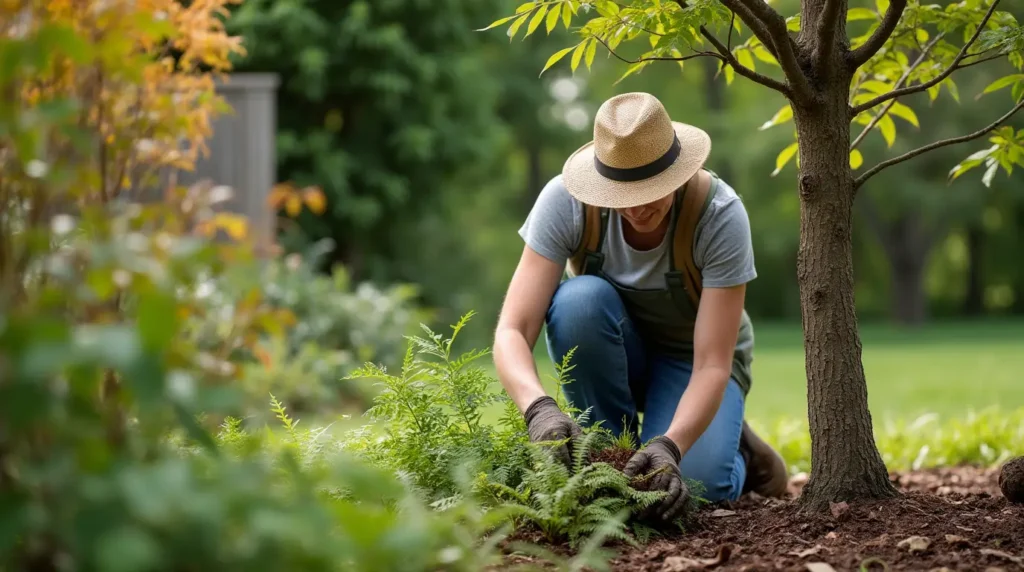
A well-designed woodland garden thrives on its natural aesthetic, requiring less upkeep than traditional gardens. However, regular maintenance ensures the space remains healthy, visually appealing, and functional. Here’s how to care for your woodland retreat effectively:
Soil Health and Mulching
Rich, healthy soil forms the cornerstone of a vibrant woodland garden. Mimic natural forest conditions to maintain soil fertility.
- Add organic matter: Periodically enrich the soil with leaf mold, compost, or well-rotted manure to maintain nutrient levels.
- Use natural mulches: Spread a layer of shredded bark, wood chips, or fallen leaves around plants to retain moisture, regulate soil temperature, and suppress weeds.
- Monitor soil pH: Woodland plants often prefer slightly acidic soil. Test your soil periodically and amend it with sulfur or lime if needed.
Weed Control
While a woodland garden should have a natural feel, weeds can compete with desired plants for nutrients and space.
- Regular weeding: Hand-pull weeds early in the season before they establish deep roots.
- Groundcovers: Plant dense, shade-loving groundcovers like vinca or wild ginger to crowd out weeds naturally.
- Mulching: Mulch also acts as a barrier to prevent weed growth.
Pruning and Deadheading
Proper pruning keeps your woodland garden tidy and encourages healthy growth.
- Tree maintenance: Prune dead or overhanging branches to allow more light into the garden and reduce safety risks.
- Shrubs and perennials: Remove spent flowers and leggy growth to encourage a neat appearance and continuous blooming.
- Deadheading: Cut back faded blooms on plants like hydrangeas or astilbes to promote fresh growth and prevent self-seeding.
Watering Practices
Woodland gardens are typically designed to thrive in moist conditions, but some areas may require supplemental watering, especially during dry spells.
- Deep watering: Water deeply but infrequently to encourage plants to develop deep roots.
- Drip irrigation: Use a drip irrigation system to deliver water directly to the roots, minimizing waste.
- Rain collection: Install a rain barrel to harvest water naturally, aligning with the eco-friendly ethos of a woodland garden.
Pest and Wildlife Management
Woodland gardens are havens for wildlife, but some animals and pests may disrupt the ecosystem.
- Beneficial insects: Encourage natural predators like ladybugs and lacewings to keep pest populations in check.
- Barriers and repellents: Use natural deterrents like garlic sprays or physical barriers to protect vulnerable plants from deer, rabbits, or slugs.
- Birdhouses: Attract insect-eating birds to help control pests while adding movement and sound to your garden.
Seasonal Cleanup and Adjustments
Adjust your maintenance routine to the changing seasons to keep your garden thriving year-round.
- Spring: Clear away any winter debris, refresh mulch, and prune deadwood. Plant spring bulbs if needed.
- Summer: Focus on watering and weeding while deadheading spent flowers for continued blooms.
- Autumn: Allow some leaves to decompose naturally, but clear paths and delicate areas. Consider planting new trees or shrubs.
- Winter: Protect tender plants with burlap or mulch and prune trees to prevent damage from heavy snow.
Encouraging Natural Growth
A woodland garden’s charm lies in its semi-wild appearance. Avoid over-managing the space to let nature take its course.
- Self-seeding plants: Let native wildflowers and perennials spread naturally to fill gaps and enhance biodiversity.
- Moss and fungi: Allow mosses and fungi to thrive as they contribute to the garden’s woodland ambiance and ecosystem health.
- Fallen wood: Leave some fallen branches or logs to decompose naturally, providing habitat for insects and enriching the soil over time.
By adopting these maintenance strategies, you can preserve the tranquil beauty of your woodland retreat while keeping it healthy and inviting. A little regular care goes a long way in sustaining a garden that continues to bring joy for years to come.
Conclusion
Creating a garden in the woods is a deeply rewarding experience that blends the serenity of nature with the creativity of gardening. By embracing the principles of woodland gardening, you can design a tranquil retreat that serves as a peaceful sanctuary, a haven for wildlife, and a sustainable space that requires minimal maintenance.
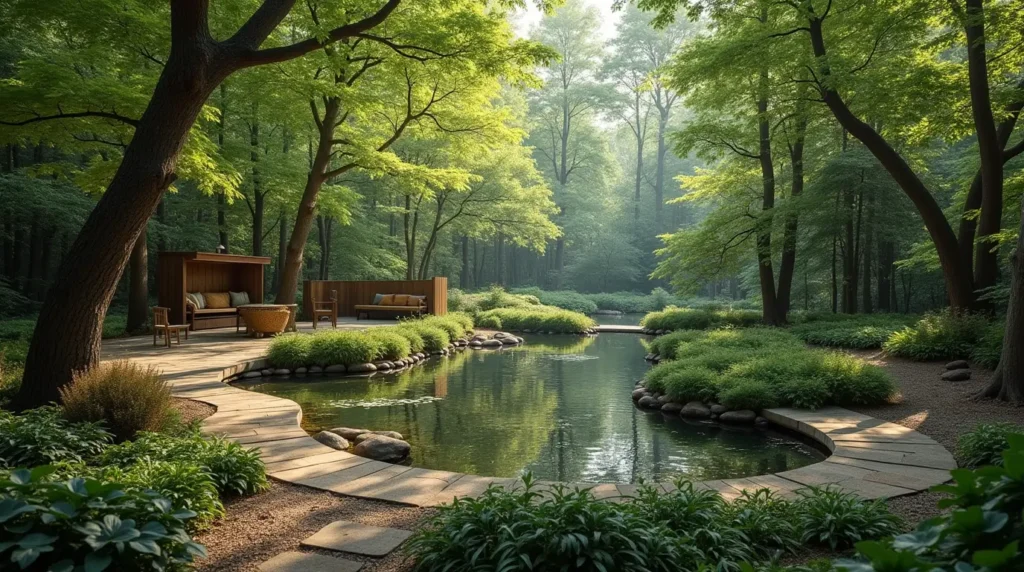
A Harmonious Blend with Nature
A woodland garden allows you to immerse yourself in the beauty of nature while maintaining a sense of harmony with the environment. The key to its success lies in understanding the unique features of woodland spaces—shaded areas, rich soil, and a natural, layered ecosystem. By choosing the right plants, incorporating natural elements like water features and stone accents, and fostering biodiversity, your garden will evolve into a vibrant, thriving space.
Sustainability and Low Maintenance
One of the greatest advantages of woodland gardening is its sustainability. By selecting native plants, using organic practices, and creating an ecosystem that supports local wildlife, your garden becomes an eco-friendly retreat. The low-maintenance nature of woodland gardens, with their natural groundcovers, organic mulches, and self-sustaining plant layers, reduces the need for constant upkeep. This allows you to spend more time enjoying the peaceful beauty of your garden instead of working on it.
A Year-Round Retreat
While woodland gardens often evoke the cool, tranquil beauty of shaded forests, they offer year-round interest. From the vibrant wildflowers of spring to the striking colors of autumn foliage and the quiet elegance of winter evergreens, a woodland garden changes with the seasons, keeping the landscape dynamic and engaging. By thoughtfully choosing plants with seasonal appeal and incorporating features like water elements and wooden structures, you create a space that remains beautiful no matter the time of year.
Personalizing Your Woodland Retreat
At its core, a woodland garden is a personal project—a reflection of your style, your appreciation for nature, and your desire for a peaceful retreat. As you implement design tips, choose plants, and incorporate natural elements, you’ll shape a space that feels uniquely yours. Whether you prefer the soft touch of moss-covered stones, the sound of a babbling brook, or the quiet rustling of trees, your garden will become a place to relax, recharge, and connect with nature.
Final Thoughts
A garden in the woods is more than just a beautiful outdoor space—it’s a living, evolving work of art that mirrors the natural world. It offers a sense of tranquility and connection to the earth, allowing you to escape the hustle and bustle of everyday life. By understanding the essence of woodland gardening, planning your retreat thoughtfully, and nurturing it with care, you can create a woodland paradise that brings joy and peace for many years to come.
So, take inspiration from the natural beauty around you, embrace the quiet elegance of the woods, and begin designing your perfect woodland retreat today.

